ICND2 – EIGRP Questions 2
[am4show have=’p2;’]
Premium Member: You can test your knowledge with these questions first via this link.
[/am4show]
Question 1
[am4show have=’p2;’]What does a router do if it has no EIGRP feasible successor route to a destination network and the successor route to that destination network is in active status?
A. It routes all traffic that is addressed to the destination network to the interface indicated in the routing table.
B. It sends a copy of its neighbor table to all adjacent routers.
C. It sends a multicast query packet to all adjacent neighbors requesting available routing paths to the destination network.
D. It broadcasts Hello packets to all routers in the network to re-establish neighbor adjacencies.
Answer: C[/am4show]
Explanation
When a router has no EIGRP feasible successor and the successor route to that destination network is in active status (the successor route is down, for example) a route recomputation occurs. A route recomputation commences with a router sending a query packet to all neighbors. Neighboring routers can either reply if they have feasible successors for the destination or optionally return a query indicating that they are performing a route recomputation. While in Active state, a router cannot change the next-hop neighbor it is using to forward packets. Once all replies are received for a given query, the destination can transition to Passive state and a new successor can be selected.
(Reference: http://www.cisco.com/en/US/tech/tk365/technologies_tech_note09186a0080093f07.shtml#rout_states)
Question 2
[am4show have=’p2;’]Which statement describes an EIGRP feasible successor route?
A. A primary route, added to the routing table
B. A backup route, added to the routing table
C. A primary route, added to the topology table
D. A backup route, added to the topology table
Answer: D[/am4show]
Question 3
[am4show have=’p2;’]Refer to the exhibit. How will the router handle a packet destined for 192.0.2.156?
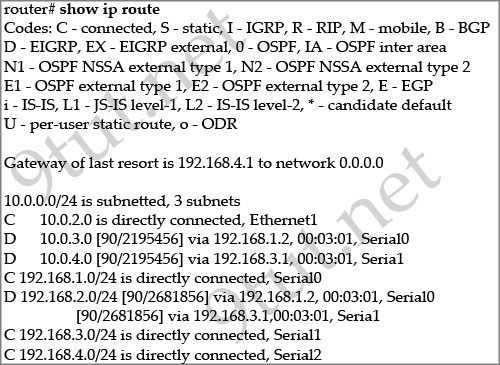
A. The router will drop the packet.
B. The router will return the packet to its source.
C. The router will forward the packet via Serial2.
D. The router will forward the packet via either Serial0 or Serial1.
Answer: C[/am4show]
Explanation
From the output we see a line “Gateway of last resort is 192.168.4.1 to network 0.0.0.0”. Gateway of last resort refers to the next-hop router of a router’s current default route. Therefore all the traffic through this router to destination networks not matching any other networks or subnets in the routing table will be sent to 192.168.4.1 (which is on Serial2) -> packet destined for 192.0.2.156 (or an unknown destination) will be forwarded via Serial2.
An weird thing in the output above is the missing of the asterisk mask (*) which represents for the candidate default route. To set the “Gateway of last resort is 192.168.4.1 to network 0.0.0.0” as the output above we can use these commands:
ip route 0.0.0.0 0.0.0.0 192.168.4.1
ip default-network 192.168.4.0
But these commands will create an static routing in the routing table with an asterisk mask. Maybe the output shown above is missing that route.
For more information about the command ip default-network please visit: http://www.cisco.com/en/US/tech/tk365/technologies_tech_note09186a0080094374.shtml.
Question 4
[am4show have=’p2;’]Refer to the exhibit. From RouterA, a network administrator is able to ping the serial interface of RouterB but unable to ping any of the subnets attached to RouterB. Based on the partial outputs in the exhibit, what could be the problem?
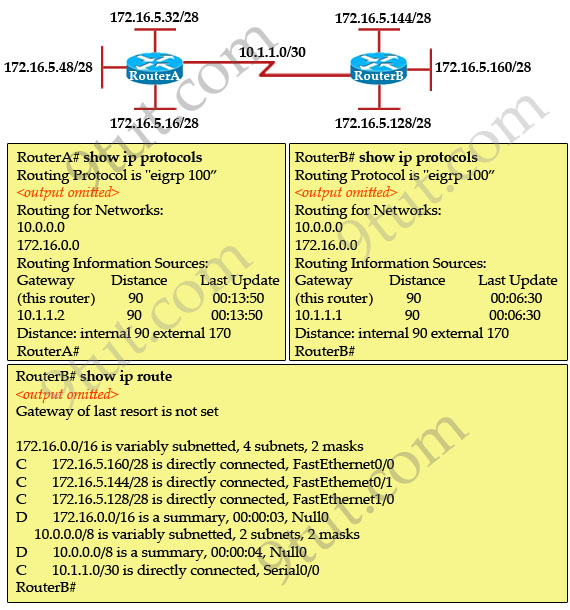
A. EIGRP does not support VLSM.
B. The EIGRP network statements are incorrectly configured.
C. The IP addressing on the serial interface of RouterA is incorrect.
D. The routing protocol has summarized on the classful boundary.
E. EIGRP has been configured with an invalid autonomous system number.
Answer: D[/am4show]
Explanation
From the output of “show ip route” command on RouterB, we learn that RouterB does not learn any networks in RouterA. Also the “172.16.0.0/26 is a summary, 00:00:03, Null0” line tells us this netwok is summarized.
Note: EIGRP performs auto-summarization each time it crosses a border between two major networks. For example, RouterA has networks of 172.16.x.x. It will perform auto-summarization when sending over network 10.1.1.0/30, which is in different major network (172.16.0.0/16 and 10.0.0.0/8 are called major networks in this case).
Question 5
[am4show have=’p2;’]Refer to the exhibit. The Lakeside Company has the internetwork in the exhibit. The Administrator would like to reduce the size of the routing table to the Central Router. Which partial routing table entry in the Central router represents a route summary that represents the LANs in Phoenix but no additional subnets?
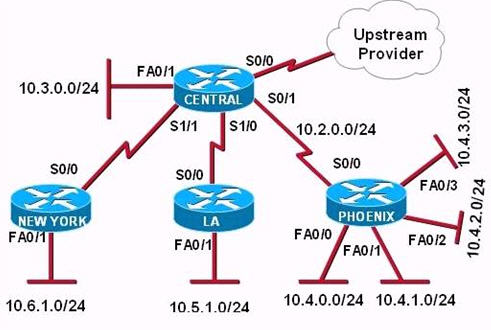
A – 10.0.0.0 /22 is subnetted, 1 subnet
D 10.0.0.0 [90/20514560] via 10.2.0.2 6w0d, serial 0/1
B – 10.0.0.0 /28 is subnetted, 1 subnet
D 10.2.0.0 [90/20514560] via 10.2.0.2 6w0d, serial 0/1
C – 10.0.0.0 /30 is subnetted, 1 subnet
D 10.2.2.0 [90/20514560] via 10.2.0.2 6w0d, serial 0/1
D – 10.0.0.0 /22 is subnetted, 1 subnet
D 10.4.0.0 [90/20514560] via 10.2.0.2 6w0d, serial 0/1
E – 10.0.0.0 /28 is subnetted, 1 subnet
D 10.4.4.0 [90/20514560] via 10.2.0.2 6w0d, serial 0/1
F – 10.0.0.0 /30 is subnetted, 1 subnet
D 10.4.4.4 [90/20514560] via 10.2.0.2 6w0d, serial 0/1
Answer: D[/am4show]
Explanation
All the above networks can be summarized to 10.0.0.0 network but the question requires to “represent the LANs in Phoenix but no additional subnets” so we must summarized to 10.4.0.0 network. The Phoenix router has 4 subnets so we need to “move left” 2 bits of “/24”-> /22 is the best choice -> D is correct.
Question 6
[am4show have=’p2;’]The company uses EIGRP as the routing protocol.
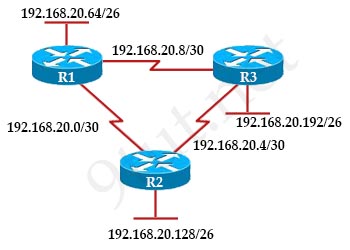
R3# show ip route
Gateway of last resort is not set
192 168.20.0/24 is variably subnetted, 6 subnets, 2 masks
D 192.168.20.64/26 [90/2195456] via 192.168.20.9, 00:03:31, Serial0/0
D 192.168.20.0/30 [90/2681856] via 192.168.20.9, 00:03:31, Serial0/0
C 192.168.20.4/30 is directly connected, Serial 0/1
C 192.168.20.8/30 is directly connected, Serial 0/0
C 192.168.20.192/26 is directly connected, FastEthernet0/0
D 192.168.20.128/26 [90/2195456] via 192.168.20.5,00:03 31, Serial 0/1
What path will packets take from a host on 192.168.20.192/26 network to a host on the LAN attached to router R1?
A. The path of the packets will be R3 to R2 to R1.
B. The path of the packets will be R3 to R1 to R2.
C. The path of the packets will be both R3 to R2 to R1 and R3 to R1.
D. The path of the packets will be R3 to R1.
Answer: D[/am4show]
Explanation
From the line “D 192.168.20.64/26 [90/2195456] via 192.168.20.9, 00:03:31, Serial0/0″ we can see the IP address 192.168.20.9 belongs to network 192.168.20.8/30 and this network is between R1 and R3 -> Packet from 192.168.20.192/26 network destined to a host on the LAN attached to router R1 will go directly from R3 to R1.
Question 7
[am4show have=’p2;’]Which statements are true about EIGRP successor routes? (Choose two)
A. A successor route is used by EIGRP to forward traffic to a destination.
B. Successor routes are saved in the topology table to be used if the primary route fails.
C. Successor routes are flagged as “active” in the routing table.
D. A successor route may be backed up by a feasible successor route.
E. Successor routes are stored in the neighbor table following the discovery process.
Answer: A D[am4show have=’p2;’]
Explanation
C is not correct because successor routes are not flagged as “active”, they are always the best route to reach remote networks and are always used to send packets.
A and D are correct because successor route is the best and primary route to a remote network. It is stored in the routing table and topology table. If this route fails, a backup route (called feasible successor route) in the topology table will be used to route traffic to a destination.
E is not correct because neighbor table only contains a list of directly connected EIGRP routers that have an adjacency with this router, it doesn’t contain successor routes.
Question 8
[am4show have=’p2;’]What address is a feasible successor?
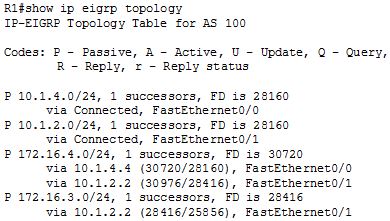
A. 172.16.4.0
B. 10.1.4.4
C. 10.1.2.2
D. 172.16.3.0
Answer: C[/am4show]
Question 9
[am4show have=’p2;’]A network administrator is troubleshooting an EIGRP problem on a router and needs to confirm the IP addresses of the devices with which the router has established adjacency. The retransmit interval and the queue counts for the adjacent routers also need to be checked.
What command will display the required information?
A. Router# show ip eigrp topology
B. Router# show ip eigrp interfaces
C. Router# show ip eigrp adjacency
D. Router# show ip eigrp neighbors
Answer: D[/am4show]
Explanation
Below is an example of the “show ip eigrp neighbors” command (from 9tut.com)



Question 7 repeats the question in “EIGRP Questions”
Sorry, Guys Where this questions
can I please have the questions
Question 6, the path is from R3 to R1 because of the lower AD than the R3 – R2 – R1 path
er 14th, 2017
Question 6, the path is from R3 to R1 because of the lower *FD than the R3 – R2 – R1 path
On question 9, answer is C because: the AD of the 10.1.2.2 is less than the FD of the 10.1.4.4
Can anyone explain question 9? Or feasible successors in general? Thanks
To qualify as a feasible successor, a router must have an AD less than the FD of the current successor route (FD/AD)
Q8 – Answer C, just looking at the output, there is only 1 FS , notice how they put …show ip eigrp topology, hint the FS will show in the topology output not show ip route, and out of all the routes listed only 1 has a FS.
On question 9, I’m getting right confused.
In this case, we see 10.1.2.2 shows an AD less than the current successor of 10.1.4.4 is what I keep reading. But to me, I can’t see how the Successor route is 10.1.4.4 as that isn’t the lowest AD, and then there are other AD’s less than 10.1.2.2.
Actually, thanks Bizz I think I get it now. No others have FS so the only one with an FS must be the successor.
Please clarify question 8. How come its not 10.1.4.4?
on q8.the feasible successor is an alternative backup route when the successor route fails. From the four networks listed , only 172.16.4.0/24 has two possible routes. 10.1.1.4 will be listed as primary route (successor) on the routing table because it has a FD of 30720.
the other route 10.1.2.2 has a RD of 28416 which is less than 30720 that will make it feasible successor.
10.1.1.4 can not be a successor and feasible successor route as the same time.
I think the Q.8 needs explanation because I think there can be two answers: for 172.16.4.0 network the feasible successor can be 10.1.4.4 whose reported distance is less than current feasible distance, which is enough for feasibility condition. The second right answer is same as stated in answers here.
in order to see the questions you have to register and pay 19$, the membership is active for one month, then you have to re-subscribe
Q8
For network 172.16.4.0/24
10.1.4.4 is the successor (as it is first ) 30720 FD and RD is 28160
10.1.2.2 is the feasible successor ( as it is second ). FD 30976 RD 28416
the reason why it says there is only one successor is because there would need to be another
Entry with the same FD and RD for example :
For network 172.16.4.0/24
10.1.4.4 is the successor 30720 FD and RD is 28160
10.1.2.2 is the successor 30720 FD and RD 28160
This would mean there is no feasible successor but 2 successors